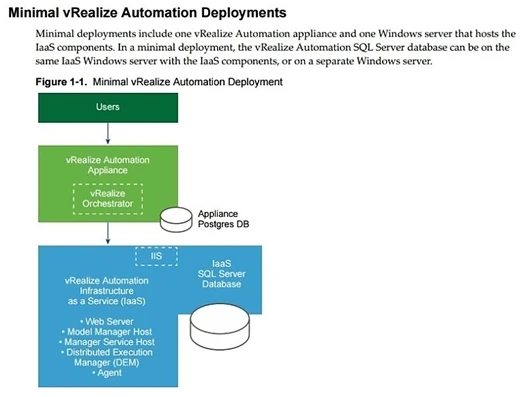Question 6 of 115
A compute resource in a fabric group has 100 GB of memory. The following memory reservations were created from the compute resource:
Business Group A: 60 GB -
Business Group B: 60 GB -
What would be the expected result of this configuration?
Business Group A: 60 GB -
Business Group B: 60 GB -
What would be the expected result of this configuration?
Correct Answer: D
The memory reservations for both Business Group A and Business Group B exceed the total memory capacity of the compute resource, which is only 100 GB. Consequently, this configuration would result in an error as the combined memory reservations (120 GB) surpass the available memory.
Question 7 of 115
Which two options are supported for the laaS database in a minimal deployment of vRealize Automation? (Choose two.)
Correct Answer: A, B AB
AB
 AB
ABQuestion 8 of 115
Which two statements are true when configuring redundant, high availability vRealize Automation proxy agents for one vCenter Endpoint? (Choose two.)
Correct Answer: A, C
Question 9 of 115
The vRealize Orchestrator Server Configuration for XaaS activity needs to be pointed to an external server for all current and future tenants. The default server configuration is currently in use.
Which two options accomplish this task? (Choose two.)
Which two options accomplish this task? (Choose two.)
Correct Answer: A, D
Question 10 of 115
An external vRealize Orchestrator is being configured to automate items in vRealize Automation. The plug-in is installed, but an administrator is still unable to automate items in vRA.
Which two items below will enable vRO to automate items in vRA, including aspects of laaS? (Choose two.)
Which two items below will enable vRO to automate items in vRA, including aspects of laaS? (Choose two.)
Correct Answer: A, D
To enable vRealize Orchestrator (vRO) to automate items in vRealize Automation (vRA), including aspects of IaaS, two steps are crucial. First, adding an IaaS host to vRO using the workflow ensures that vRO can interact with the IaaS components of vRA. Second, adding a vRA host to vRO using the workflow is necessary for enabling vRO to communicate and execute automation tasks within the vRA environment.